.
9.03.2015

ISS042E292504 (03/01/2015) — U.S. astronaut Terry Virts observed this scene from the International Space Station on Mar. 1, 2015. He sent this image via Twitter with the remark, “The camera doesn’t do it justice – floating in space, looking down on creation, seeing new color shades”.
-
Expedition 42 crew members Barry Wilmore, Alexander Samokutyaev and Elena Serova are two days away from ending their stay aboard the International Space Station. The trio is packing gear and cleaning crew quarters as they prepare to undock in their Soyuz TMA-14M spacecraft Wednesday at 6:44 p.m. EST and land in Kazakhstan at 10:07 p.m.
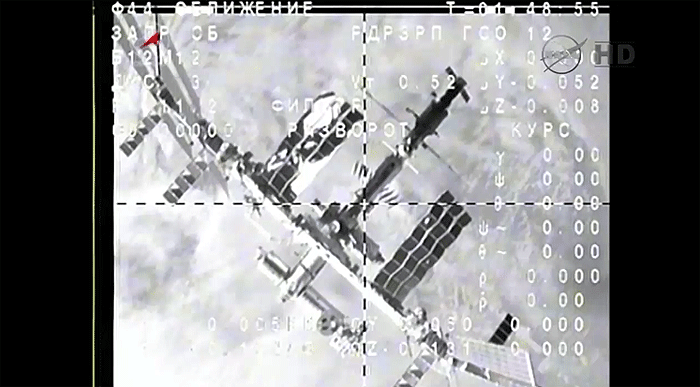

Wilmore, the commander of Expedition 42, will handover control of the orbital laboratory Tuesday to NASA astronaut Terry Virts who will command Expedition 43. The Change of Command Ceremony will take place live on NASA TV at 10:25 a.m.
Meanwhile, advanced microgravity science and laboratory maintenance is ongoing aboard the space station. Among the experiments, the crew studied body size and shape in space for suit sizing and looked at airway inflammation in astronauts. Ethernet cables were also installed in the Harmony module that will enable future commercial crew vehicles to communicate with a pair of upcoming International Docking Adapters.
Quelle: NASA
-
Soyuz TMA-14M Crew to Depart Space Station Wednesday After 5.5-Month Mission
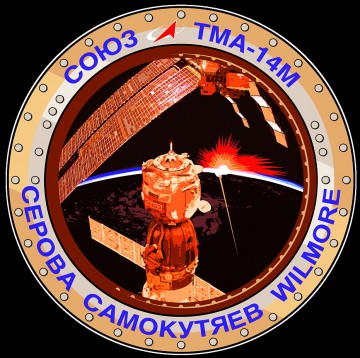
After more than five months in orbit, Soyuz TMA-14M and its crew of Russian cosmonauts Aleksandr Samokutyayev and Yelena Serova, together with NASA astronaut Barry “Butch” Wilmore, will depart the International Space Station (ISS) on Wednesday, 11 March, for their return to Earth. Current planning anticipates an undocking from the station’s space-facing (or “zenith”) Poisk module late Wednesday and, following a fiery descent back through the “sensible” atmosphere, will land in Kazakhstan about 3.5 hours later. Assuming an on-time undocking and touchdown, Samokutyayev, Serova, and Wilmore will complete a mission of more than 167 days and in excess of 71 million miles (114 million km) traveled. Their return to Earth will close out a hugely successful Expedition 42 and leave the ISS under the command of U.S. astronaut Terry Virts, as Expedition 43—and an ambitious 2015—gets formally underway.
It has been more than two years since NASA formally announced the names of Samokutyayev, Serova, and Wilmore as the crew of Soyuz TMA-14M, launching in September 2014 as the second half of Expedition 41 and rotating into the “core” of Expedition 42 from November through March 2015. As the ISS headed toward its Commercial Crew goals, it was obvious that their six-month voyage would be an exciting and dramatic one, with up to three EVAs planned to lay cables and utilities in readiness for the installation of two International Docking Adapters (IDAs) and to prepare for the arrival and relocation of several ISS modules. Moreover, a near-constant flow of unpiloted visiting vehicles—Russia’s Progress, the European Space Agency’s (ESA) fifth and final Automated Transfer Vehicle (ATV-5), SpaceX’s Dragon, and Orbital Sciences’ Cygnus—were expected to deliver food, water, fuel, equipment, and supplies to the crew, in support of a full plate of scientific and biomedical research.
With two missions between them on the day of launch, the Soyuz TMA-14M crew roared into orbit from Site 1/5 at Baikonur Cosmodrome in Kazakhstan at 2:25 a.m. local time on 26 September (4:25 p.m. EDT on the 25th), bound for a standard six-hour, four-orbit “fast rendezvous” profile to reach the space station. However, all did not go according to plan. The crew entered an orbit slightly higher than targeted, though well within tolerances, but it became clear that the spacecraft’s port-side solar array had not deployed. This required flight controllers to rely upon the on-board batteries to pick up the power shortfall and support the four maneuvers needed to get to the ISS.
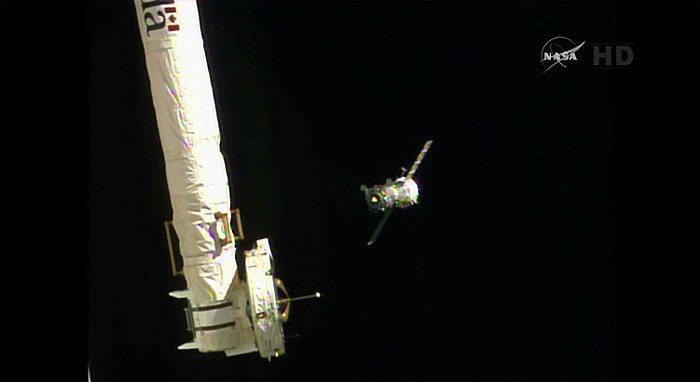
Telemetry indicated that the stubborn array’s deployment mechanism had actuated and it was hoped that the maneuvering burns would jolt it open, but this did not occur. During the final approach to the station, Russian cosmonaut Max Surayev—commander of Expedition 41, alongside U.S. astronaut Reid Wiseman and Germany’s Alexander Gerst, who had been aboard since May—reported that the array remained undeployed and Samokutyayev completed a perfect docking at the space-facing (or “zenith”) Poisk module at 10:11 p.m. EDT, as the two vehicles passed high above the Pacific Ocean, off the coast of South America. Happily, the force imparted by docking appeared to cause the solar array to finally jolt itself open.
As Samokutyayev, Serova, and Wilmore joined Expedition 41 and restored the station’s crew to its full six-person strength, theirs was just the latest in a series of vehicles to call the ISS home. Already in place was Russia’s Progress M-24M, which had been docked at the Earth-facing (or “nadir”) port of the Pirs module since July, as well as Europe’s ATV-5, which had been attached to the aft longitudinal port of the Zvezda module since August, and SpaceX’s fourth Commercial Resupply Services Dragon mission (CRS-4), which had arrived and been berthed at the nadir port of the Harmony node a few days earlier, on 23 September. Interestingly, one of the CRS-4 payloads was a pair of critical Long Life Batteries (LLBs) for the U.S. Extravehicular Mobility Units (EMUs). Another pair was carried about Soyuz TMA-14M itself, allowing for a pair of U.S. spacewalks by Wiseman, Gerst, and Wilmore in October. These excursions were originally planned for August 2014, during Expedition 40, but were delayed when a failure was detected in one of the lithium-ion LLBs already aboard the space station.The first spacewalk, designated “U.S. EVA-27,” took place on 7 October, and featured Wiseman and Gerst spending six hours and 13 minutes outside the ISS. Supported by Wilmore, who acted as the “intravehicular” crewman and assisted the men with their suits, Wiseman and Gerst moved a failed pump module from a temporary to a long-term storage location, replaced a failed camera light, and installed a new relay assembly to provide power redundancy for the Mobile Transporter (MT), along which the 57.7-foot-long (17.6-meter) Canadarm2 robotic arm traverses between its various work sites. During the course of EVA-27, Wilmore was at the controls of Canadarm2, working from the multi-windowed cupola, but a few days later, on 15 October, his own opportunity came to perform his first career spacewalk. Teamed with Wiseman, he spent six hours and 34 minutes outside the station, replacing a failed Sequential Shunt Unit (SSU) and relocating cameras and equipment, in readiness of the scheduled mid-2015 arrival of the IDAs. A week later, on 22 October, cosmonauts Surayev and Samokutyayev headed outside the ISS for three hours and 38 minutes to remove and discard a scientific experiments package and a pair of unneeded rendezvous antennas, as well as collecting samples from the exterior of the Russian Orbital Segment (ROS) and conducting a comprehensive photo-documentation effort.




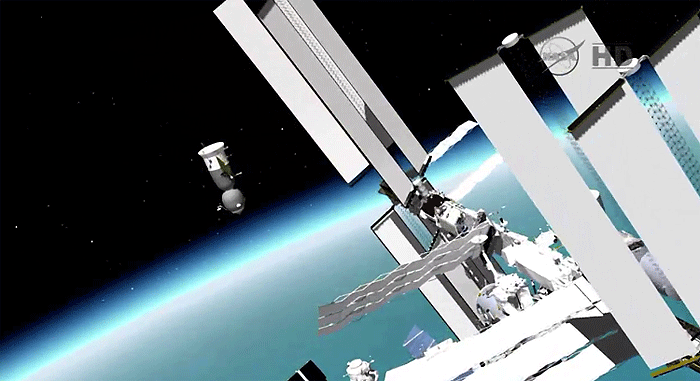
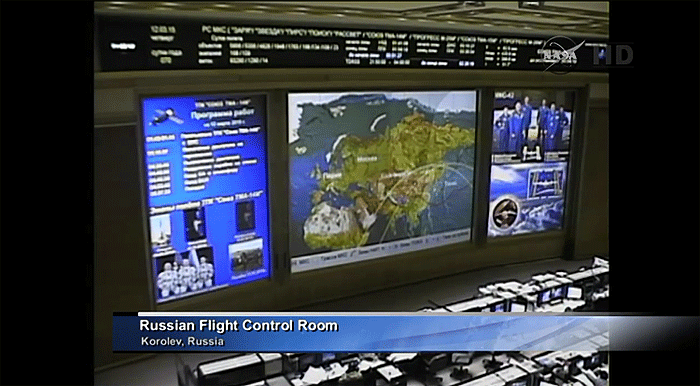



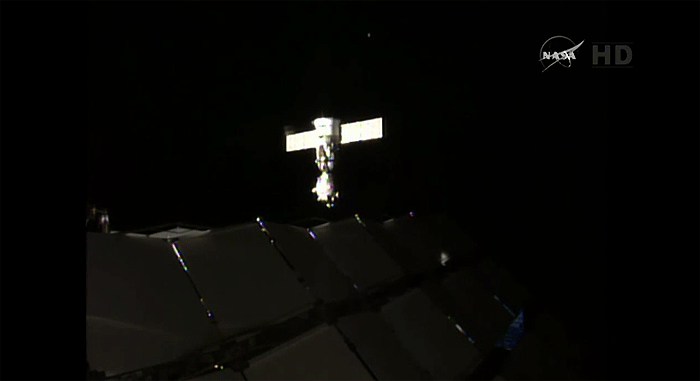

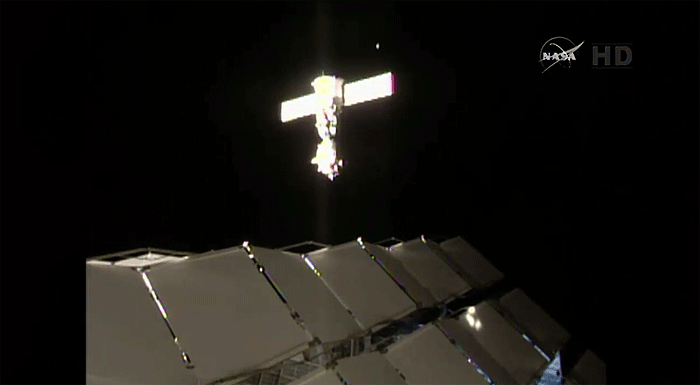





By this stage, Expedition 41 was entering its final days and after the successful arrival of Russia’s Progress M-25M the crew was expecting the delayed arrival of Orbital Sciences’ third dedicated Cygnus cargo mission (ORB-3) at the end of October. However, calamity struck the mission—as highlighted dramatically in an AmericaSpace Photo Feature—on 29 October, when the Antares launch vehicle exploded, seconds after liftoff and collapsed back onto Pad 0A at the Mid-Atlantic Regional Spaceport (MARS) on Wallops Island, Va. The accident destroyed the Cygnus cargo craft, which was named in honor of former astronaut Deke Slayton and was laden with Orbital’s largest-ever load of equipment and supplies for the ISS crew, totaling 5,050 pounds (2,290 kg). It also effectively grounded the aspirations of one of NASA’s two Commercial Resupply Services partners until at least the fall of 2015 and suspended operations with the Antares booster until the spring of 2016.
In the meantime, the outgoing members of the Expedition 41 crew prepared for their return to Earth, after 5.5 months in orbit, and on 8 November, a ceremony saw Max Surayev hand command to Butch Wilmore. This marked the official start of Expedition 42, the 42nd long-duration mission to the ISS, following a continuous and unbroken chain, extending back to the arrival of Expedition 1 crewmen Bill Shepherd of NASA and Russian cosmonauts Sergei Krikalev and Yuri Gidzenko, way back in November 2000. Two days after handing over command, Surayev undocked Soyuz TMA-13M from the station and brought himself, Wiseman and Gerst to a safe touchdown in Kazakhstan, to the north-east of the town of Arkalyk, on 9/10 November, ending 165 days in orbit.
Expedition 42 continued as a three-member team for the next two weeks, until the launch of Soyuz TMA-15M and the second half of the crew, Russian cosmonaut Anton Shkaplerov, U.S. astronaut Terry Virts, and Italy’s first woman in space, Samantha Cristoforetti. During this interval—as described by AmericaSpace’s Sherry Valare in one of her regular ISS status reports—Samokutyayev, Serova, and Wilmore undertook scientific research, cargo transfers, and maintenance activities. At 3:01 a.m. local time on 24 November (4:01 p.m. EST on the 23rd), Shkaplerov, Virts, and Cristoforetti were boosted successfully into orbit from Baikonur and accomplished a perfect docking at the nadir-facing Rassvet module, about six hours later. One item accompanying Cristoforetti, and attracting much media attention, was the first-ever space-rated espresso machine.

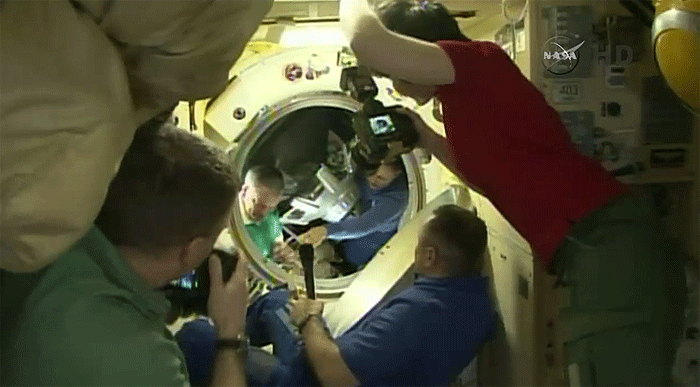
With the crew restored to six-person strength, Expedition 42 would make history by marking the first occasion in history on which two women—Russia’s Serova and Italy’s Cristoforetti—had been in orbit over the Christmas and New Year period. The astronauts and cosmonauts set to work on an enormous workload of scientific experiments, which included about 170 U.S. investigations and 70 others provided by international researchers in the U.S. Orbital Segment (USOS) alone. As described by Sherry Valare, this included 3-D printing applications and preparations for the slightly delayed arrival of SpaceX’s CRS-5 Dragon mission, originally targeted for mid-December. However, the mission was realigned for launch in early January 2015, which conspired to push a trio of planned U.S. EVAs by Wilmore and Virts into the mid-February timeframe.
After celebrating Christmas and the New Year in space, it was clear that 2015 would shape up to be one of the most significant years in ISS Program history. As outlined in two AmericaSpace articles, which can be found here and here, it will feature the first delivery of a large pressurized module and the first major relocation of ISS hardware in more than four years. NASA’s Commercial Crew aspirations will see SpaceX’s Dragon V-2 and Boeing’s CST-100 spacecraft developed and test-flown by 2017 and they require the installation of two International Docking Adapters (IDAs) on two of the station’s Pressurized Mating Adapters (PMA-2 and 3), as well as implementation of the Common Communications for Visiting Vehicles (C2V2) architecture and the relocation of the Leonardo Permanent Multipurpose Module (PMM).
Kicking off the year, SpaceX successfully launched its CRS-5 Dragon atop a Falcon 9 booster from Space Launch Complex (SLC)-40 at Cape Canaveral Air Force Station, Fla., on 10 January, as captured in a stunning AmericaSpace imagery folio. Two days later, the cargo craft was robotically grappled by Canadarm2, operated by Wilmore and Cristoforetti, and berthed at the nadir port of the Harmony node, where it remained for the next month. During the course of this period, Europe’s ATV-5 was undocked from the ISS and burned up in the atmosphere and Russia’s Progress M-26M launched and docked successfully at the station. Other incidents which inadvertently made the news included a particularly troubling alarm on 14 January, triggered by a pressure increase in the water loop for Thermal Control System (TCS) Loop B. In a worst-case scenario, this might have been indicative of an ammonia leakage and the USOS crew of Wilmore, Virts, and Cristoforetti was ordered to move into the ROS for a few hours, until the all-clear was issued and the hatches between the two segments of the ISS was reopened.

With Expedition 42 expected to end in mid-March, there remained the three U.S. EVAs to be performed by Wilmore and Virts to lay cables and utilities for the arrival of the IDAs and in support of the C2V2 communications infrastructure, as well as outfitting the forward and aft Common Berthing Mechanisms (CBMs) of the Tranquility node for the relocation of the Leonardo Permanent Multipurpose Module (PMM) in late July and the arrival of the Bigelow Expandable Activity Module (BEAM) in September. After a 24-hour delay, caused by a minor issue with the U.S. space suits, Wilmore and Virts ventured outside the ISS on 21 February for six hours and 41 minutes on EVA-29. The duo laid 340 feet (103 meters) of IDA cables at the forward end of the Harmony node, in support of the IDA arrivals, then spent a further six hours and 43 minutes outside the station on 25 February on EVA-30. During this second spacewalk, Virts successfully lubricated elements of Canadarm2’s “sticky” Latching End Effector (LEE) and Wilmore prepared the Tranquility CBMs for their role at the center-stage of Leonardo PMM and BEAM activities, later this year.
However, EVA-30 ended on a note of caution, when Virts experienced slight water intrusion into his helmet, during the repressurization of the Quest airlock. At first, this seemed to draw unpleasant parallels with the experience of Italian astronaut Luca Parmitano, back in July 2013, but it subsequently became clear that the incident was due to a history of “sublimator water carryover” in his suit. Essentially, it was possible that a small quantity of residual water in the sublimator cooling component could condense when the environment around the suit was repressurized, following exposure to vacuum, resulting in a tiny amount of fluid pushing into the helmet. The Mission Management Team (MMT) expressed “a high degree of confidence” that the systems on Virts’ suit were in good shape and ready to support a nominal EVA-31 on 1 March. During EVA-31, Virts took the lead as “EV1” and he and Wilmore laid around 400 feet (122 meters) of C2V2 cables along the port-side P-3 and starboard-side S-3 trusses of the space station, in anticipation of future piloted and unpiloted visiting vehicles. The spacewalk concluded after five hours and 38 minutes.
With their return to Earth only a few days away, the period immediately after the conclusion of the EVAs was spent loading equipment aboard Soyuz TMA-14M for landing overnight on 11/12 March. In readiness for this event, Wilmore will turn over command of the space station to Virts tomorrow (Tuesday), thereby inaugurating Expedition 43. Undocking of Soyuz TMA-14M is presently scheduled to occur at 7:44 p.m. EDT Wednesday and will kick off a 3.5-hour return to the desolate steppe of Kazakhstan. During that period of free flight, Samokutyayev, Serova, and Wilmore will execute the 4.5-minute deorbit “burn” of their Soyuz spacecraft’s engines at about 10:16 p.m., after which they will jettison their spherical orbital module and cylindrical instrument module. With the trio ensconced inside the beehive-shaped descent module, they will then be primed to begin the perilous hypersonic descent back through the “sensible” atmosphere.





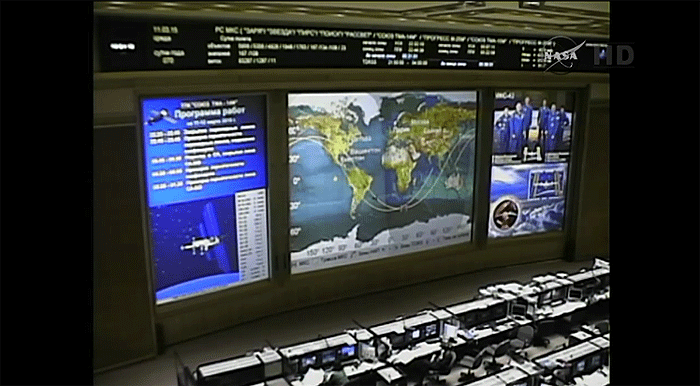

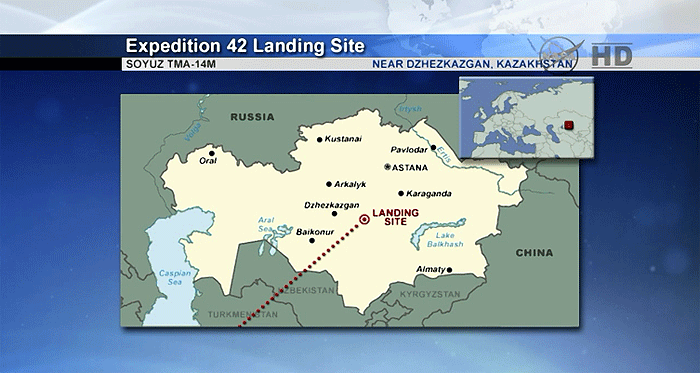


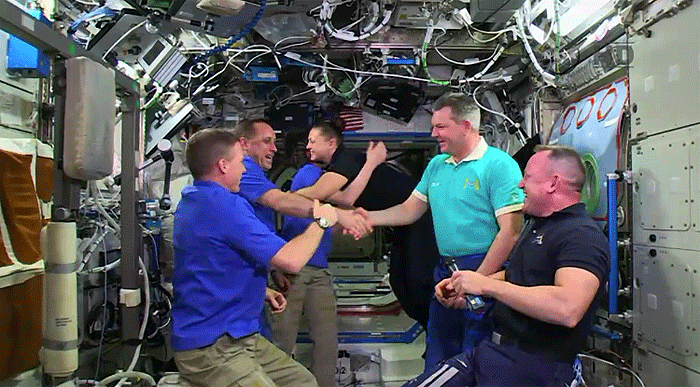

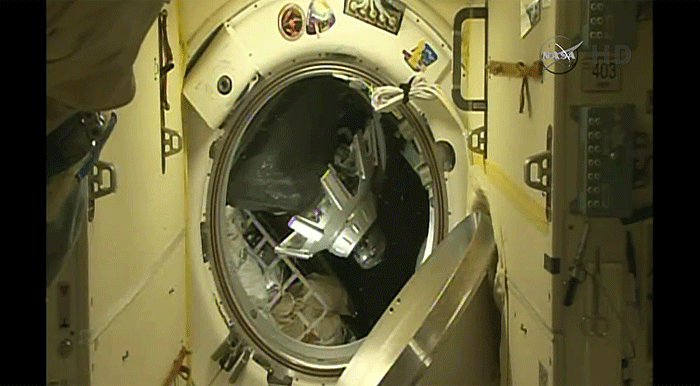
Entry Interface (EI), at an approximate altitude of 400,000 feet (122 km), should be attained about a half-hour after the deorbit burn and will be highlighted by the rapid heating of the spacecraft’s outer surfaces through friction with the steadily thickening atmospheric gases. Eight minutes later, the Soyuz TMA-14M descent module will streak, meteor-like, through the sky at a velocity in excess of 515 mph (830 km/h), heading for its touchdown in central Kazakhstan. This rate of descent will be arrested rapidly, thanks chiefly to the deployment of four parachutes, beginning about 15 minutes before it hits the ground. Two “pilot” chutes will be released, followed by a 258-square-foot (24-square-meter) drogue, which will slow the spacecraft to about 180 mph (290 km/h). Finally, the main canopy—with a fully deployed surface area of 10,764 square feet (1,000 square meters)—will be unfurled, shifting Soyuz TMA-14M’s attitude to a 30-degree angle, relative to the ground. This will steadily dissipate heat, then shift it back to a straight-vertical descent profile for landing. The main canopy will slow them to a stately 16.4 mph (26.4 km/h), still too fast for a safe landing. The turn will then come for the solid-fueled rockets in the descent module’s base, which will fire in the last two seconds to cushion the touchdown.
Assuming all goes well, Samokutyayev, Serova, and Wilmore should hit terra firma for the first time in almost six months at 8:07 a.m. local time Thursday, 12 March (11:07 p.m. EDT Wednesday). This will bring their expedition to a close after 167 days, six hours, and 42 minutes aloft and more than 71 million miles (114 million km) traveled. Returning to Earth from the second mission of his cosmonaut career, Aleksandr Samokutyayev will accrue a total of more than 331 days in orbit, which will establish him inside the Top 50 most experienced spacefarers of all time. With two career EVAs under his belt, including one from this current ISS expedition, he has spent a total of 10 hours and one minute working in the vacuum of space. Butch Wilmore—who became the first former shuttle pilot since 2003 to participate in an EVA during this expedition—will accumulate more than 178 days, as he wraps up his second mission, as well as having completed four EVAs, with a career total of 25 hours and 36 minutes. Finally, Yelena Serova, who became Russia’s fourth female cosmonaut, will establish herself as the ninth most experienced woman spacefarer of all time.
Quelle: AS
.
Update: 11.03.2015
.
Wilmore Hands Over Station Command to Virts

Expedition 42 Commander Barry Wilmore (right foreground) hands over station command to NASA astronaut Terry Virts. Credit: NASA TV
.
Expedition 42 Commander Barry Wilmore handed over control of the International Space Station to NASA astronaut Terry Virts in a Change of Command Ceremony today. Virts will lead Expedition 43 when Wilmore and Soyuz Commander Alexander Samokutyaev and Flight Engineer Elena Serova undock Wednesday at 6:44 p.m. EDT in their Soyuz TMA-14M spacecraft.
Back on Earth, a new Expedition 43 trio is relaxing as they count down to their March 27 launch. Riding with Soyuz TMA-16M Commander Gennady Padalka are One-Year crew members Scott Kelly and Mikhail Kornienko who will live in space until March 2016. Padalka will stay in space till September.
Meanwhile inside the station, Virts continues installing cables so future commercial crew vehicles can communicate with a pair of International Docking Adapters to be installed later this year. He and Flight Engineers Anton Shkaplerov and Samantha Cristoforetti also reviewed their emergency roles and responsibilities and practiced communication and coordination.
.
Three International Space Station crew members are scheduled to leave the orbiting laboratory Wednesday, March 11 after almost six months in space performing scientific research and technology demonstrations.
NASA Television will provide complete coverage of their departure and return to Earth, beginning with the space station change of command ceremony on Tuesday, March 10.
Expedition 42 Commander Barry Wilmore of NASA will hand over command of the station to fellow NASA astronaut Terry Virts. At 6:44 p.m. Wednesday, Wilmore and flight engineers Alexander Samokutyaev and Elena Serova of the Russian Federal Space Agency (Roscosmos) will undock their Soyuz spacecraft from the space station and land in Kazakhstan at 10:07 p.m. (8:07 a.m. March 12 Kazakh time).
NASA Television coverage is as follows:
Tuesday, March 10
10:25 a.m. -- Change of command ceremony in which Wilmore hands over station command to Virts
Wednesday, March 11
3 p.m. -- Farewell and hatch closure coverage (hatch closure scheduled at 3:25 p.m.)
6:15 p.m. -- Undocking coverage (undocking scheduled at 6:44 p.m.)
9 p.m. -- Deorbit burn and landing coverage (deorbit burn scheduled at 9:16 p.m., with landing at 10:07 p.m.)
Thursday, March 12
12 a.m. -- Video File of hatch closure, undocking and landing activities
10:30 a.m. -- Video File of landing and post-landing activities and post-landing interview with Wilmore in Kazakhstan
Their return will complete 167 days in space since launching from Kazakhstan on Sept. 26, on a mission covering almost 71 million miles. Wilmore will have logged 178 days in space on two flights, the first of which was on space shuttle mission STS-129 in 2009. Samokutyaev will have spent 331 days in space on two flights, the first of which was on Expedition 27/28 in 2011. This was Serova’s first flight into space.
At the time of undocking, Expedition 43 officially will begin aboard the station under Virts’ command. Along with his crewmates Anton Shkaplerov of Roscosmos and Samantha Cristoforetti of ESA (European Space Agency), the three-person crew will operate the station for two weeks until the arrival of three new crew members.
NASA astronaut Scott Kelly and Russian cosmonauts Mikhail Kornienko and Gennady Padalka, are scheduled to launch from Baikonur, Kazakhstan, March 27 U.S. time (March 28 Kazakh time). Kelly and Kornienko will spend a year aboard the complex collecting valuable biomedical data that will inform future deep space, long-duration missions.
Quelle: NASA
...
Update LIVE: 19.40 MEZ
-


...






...




...




...23.12 MEZ
.


...23.45 MEZ




...23.55 MEZ




...





...











Frams: NASA-TV
4163 Views
